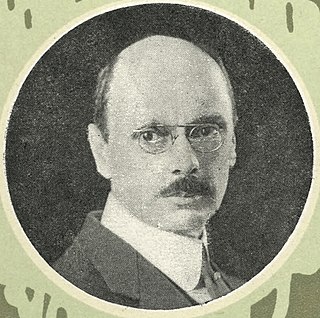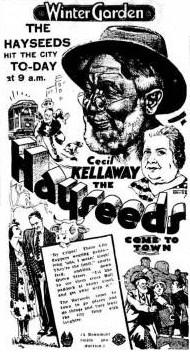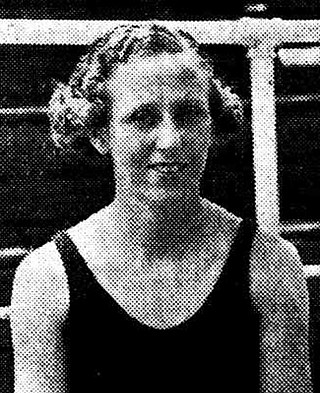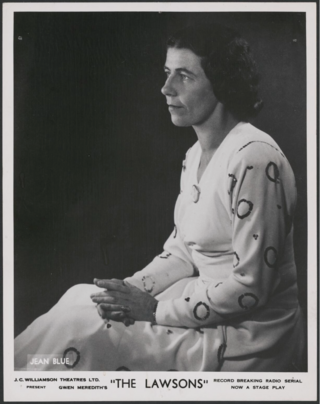
John Henry Antill, CMG, OBE was an Australian composer best known for his ballet Corroboree.
William Percy Lipscomb was a British-born Hollywood playwright, screenwriter, producer and director. He died in London in 1958, aged 71.

George Howard Clutsam was an Australian pianist, composer and writer, best remembered as the arranger of Lilac Time. Clutsam published over 150 songs.

Ethel Muriel Ashton, known professionally as Queenie Ashton, was a character actress, born in England, who had a long career in Australia as a theatre performer and radio personality, best known for her radio and television soap opera roles, although she did also feature briefly in films.

John Forde Cazabon was an English actor and stage writer whose career began in Sydney, Australia.

Corroboree is a ballet written by Australian composer John Antill in the early 1940s. The first full version of the score was completed in 1944 and it was first performed as a concert suite in 1946. On 3 July 1950 it was performed as a ballet, at the Empire Theatre in Sydney, choreographed by Rex Reid, with dancers of the Melbourne-based National Theatre Ballet.
Fellers is a 1930 Australian comedy about three friends in the Australian Light Horse during the Palestine Campaign of World War I starring Arthur Tauchert, who was the lead in The Sentimental Bloke (1919). The film is mostly silent with a recorded music score as an accompaniment, but the last reel was synchronised with a few minutes of dialogue and a song.

The Hayseeds is a 1933 Australian musical comedy from Beaumont Smith. It centres on the rural family, the Hayseeds, about whom Smith had previously made six silent films, starting with Our Friends, the Hayseeds (1917). He retired from directing in 1925 but decided to revive the series in the wake of the box office success of On Our Selection (1932). It was the first starring role in a movie for stage actor Cecil Kellaway.

May Hollinworth was an Australian theatre producer and director, former radio actress, and founder of the Metropolitan Theatre in Sydney. The daughter of a theatrical producer, she was introduced to the theatre at a young age. She graduated with a science degree, and worked in the chemistry department of the University of Sydney, before being appointed as director of the Sydney University Dramatic Society, a post she held from 1929 until 1943

The Bunyip, also known by the longer title The Enchantment of Fairy Princess Wattle Blossom, was written by Ella Palzier Campbell. The pantomime was a highly successful musical comedy that toured Australia for a decade within Fuller Brothers theatre circuit. The show was produced by Sydney entrepreneur Nat Philips. The premiere of the show ran for at least 97 performances and was revived several times over the following decade.
Nigel Tasman Lovell was an Australian stage, radio, film and television actor, and producer of opera and both stage and radio drama.

Minnie Everett was an Australian ballet-mistress and producer, closely associated with the J. C. Williamson's company. She was the world's first woman producer of Gilbert and Sullivan operettas.

Lurline Elsie Hook was an Australian diver who won a gold medal at the 1938 British Empire Games. She was Australian springboard champion in 1931 and six times New South Wales diving champion.
Valdemar Atkinson, invariably referred to as "Val", was an Australian theatrical producer. The youngest son of a prosperous farmer, he did much to foster amateur theatricals in Sydney and regional New South Wales. He was closely associated with J. C. Williamson's and toured amateur or semi-professional companies through regional Victoria and New South Wales, also to New Zealand. He became a producer of stage shows for the Mudgee Musical Society in the early 1920s, and developed a reputation for nurturing talent and producing successful shows, both financially and artistically. He also had some successes as a comic actor and recitalist.

Mabel Wennstrom Gibson was an Australian singer and actor, best known for playing in musicals and operettas.
Lance Fairfax was a singer and actor from New Zealand, classed as a light baritone, who had a substantial career in Australia.

The Burnie Theatre was a historic theatre in Burnie, Tasmania, Australia. The theatre, adjoining town hall, Burnie Institute and Public Library were all converted into a large FitzGerald's Department Store by 1978 and completely demolished in 2009.
Marie Alice Bremner was an Australian soprano, remembered for performances in Gilbert and Sullivan operas. She became a favorite performer in musical comedy, first on stage, then revivals and variety shows on broadcast radio. She was popular with producers for her ability to take on key roles at a moment's notice and draw "rave" reviews. Her accompanist husband Ewart Chapple became a senior executive with the Australian Broadcasting Commission.
Josephine O'Neill was an Australian film critic, journalist and poet.

Jean Blue (1906–1972) was an Australian actress, best known for The Overlanders. She worked extensively in theatre, particularly at the New Theatre in Sydney. Blue was also a trained nurse.














